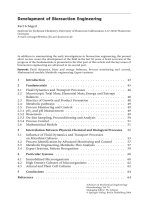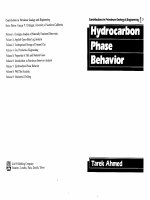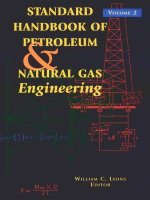PETROLEUM DEVELOPMENT GEOLOGY RESERVOIR ENGINEERING
Bạn đang xem bản rút gọn của tài liệu. Xem và tải ngay bản đầy đủ của tài liệu tại đây (900.69 KB, 55 trang )
THE RESERVOIR
PETROLEUM
RESERVOIR
• ROCK PROPERTIES
• FLUID PROPERTIES
• PRESSURE
• RESERVOIR DRIVE
ROCK PROPERTIES
Rocks are described by three properties:
– Porosity - quantity of pore space
– Permeability - ability of a formation to flow
– Matrix - major constituent of the rock
note: porosity & permeability has been discussed partially in
“Chapter I. Introduction”
PERMEABILITY
• Permeability is a property of the porous medium and is a
measure of the capacity of the medium to transmit fluids
• Absolute Perm: When the medium is completely
saturated with one fluid, then the permeability
measurement is often referred to as specific or absolute
permeability
• Effective Perm: When the rock pore spaces contain
more than one fluid, then the permeability to a particular
fluid is called the effective permeability. Effective
permeability is a measure of the fluid conductance
capacity of a porous medium to a particular fluid when
the medium is saturated with more than one fluid
• Relative Perm: Defined as the ratio of the effective
permeability to a fluid at a given saturation to the
effective permeability to that fluid at 100% saturation.
DARCY’S LAW
p2
p1
L
q
Direction of flow
qμ
L
•
k=
A ( p1 − p 2 )
k = permeability
(measured in darcies)
k/μ =
kh/μ =
A
L = length
q = flow rate
p1, p2 = pressures
A = area perpendicular to flow
μ = viscosity
DARCY’S LAW:
RADIAL FLOW
rw.
r
2πkh( P − Pw )
q=
μ ln r / rw
h = height of the cylinder (zone)
P = pressure at r
Pw = pressure at the wellbore
PERMEABILITY – POROSITY
CROSSPLOT
Sandstone A1
Limestone A1
Permeability (md)
100
1000
100
10
10
1
1
0.1
0.1
0.01
0.01
2
6
10
14
2
Porosity (%)
6
10
14
18
CALCULATING RELATIVE
PERMEABILITIES
• Oil
• Water
• Gas
k
k
k
ro
rw
rg
=
k
eo
k
=
k
=
k
ew
k
eg
k
• In a formation the minimum saturation induced by
displacement is where the wetting phase becomes
discontinuous.
• In normal water-wet rocks, this is the irreducible water
saturation, Swirr.
• Large grained rocks have a low irreducible water
saturation compared to small-grained formations
because the
capillary
pressure is
smaller.
•
•
•
The phenomenon of capillary pressure gives rise to the
transition zone in a reservoir between the water zone and the
oil zone.
The rock can be thought of as a bundle of capillary tubes.
The length of the zone depends on the pore size and the
density difference between the two fluids.
• Take a core 100% watersaturated. (A)
• Force oil into the core
until irreducible water
saturation is attained
(Swirr). (A-> C -> D)
• Reverse the process:
force water into the core
until the residual
saturation is attained. (B)
• During the process,
measure the relative
permeabilities to water
and oil.
•
Basic concepts of hydrocarbon accumulation
– Initially, pore space filled 100% with water
– Hydrocarbons migrate up dip into traps
– Hydrocarbons distributed by capillary forces and gravity
– Connate water saturation remains in hydrocarbon zone
•
Fluid saturation is defined as the fraction of pore volume
occupied by a given fluid
•
Definitions
Sw = water saturation
So = oil saturation
Sg = gas saturation
Sh = hydrocarbon saturation = So + Sg
•
Saturations are expressed as percentages or fractions, e.g.
– Water saturation of 75% in a reservoir with porosity of 20%
contains water equivalent to 15% of its volume.
• Amount of water per unit volume = φ Sw
• Amount of hydrocarbon per unit volume = φ (1 - Sw) =
φ Sh
φ
(1-Sw)
Sw
Hydrocarbon
Water
Matrix
• Lithostatic pressure is caused by the
pressure of rock, transmitted by grain-tograin contact.
• Fluid pressure is caused by weight of
column of fluids in the pore spaces.
Average = 0.465 psi/ft (saline water).
• Overburden pressure is the sum of the
lithostatic and fluid pressures.
• Reservoir Pressures are normally controlled by the
gradient in the aquifer.
• High pressures exist in some reservoirs.
The chart shows three possible temperature gradients. The
temperature can be determined if the depth is known.
High temperatures exist in some places. Local knowledge is important.
• A reservoir normally contains either water or
hydrocarbon or a mixture.
• The hydrocarbon may be in the form of oil or
gas.
• The specific hydrocarbon produced depends
on the reservoir pressure and temperature.
• The formation water may be fresh or salty.
• The amount and type of fluid produced
depends on the initial reservoir pressure,
rock properties and the drive mechanism.
•
Typical hydrocarbons have the following composition in Mol Fraction
•
Hydrocarbon
C1
C2
C3
C4
C5
C6+
•
Dry gas
.88
.045
.045
.01
.01
.01
•
Condensate
.72
.08
.04
.04
.04
.08
•
Volatile oil
.6-.65
.08
.05
.04
.03
.15-.2
•
Black oil
.41
.03
.05
.05
.04
.42
•
Heavy oil
.11
.03
.01
.01
.04
.8
•
Tar/bitumen
•
The 'C' numbers indicated the number of carbon atoms in the molecular chain.
1.0
• The major
constituent of
hydrocarbons is
paraffin.
•
Hydrocarbons are also defined by their weight and the Gas/Oil ratio. The
table gives some typical values:
GOR
API Gravity
•
Wet gas
100mcf/b
50-70
•
Condensate
5-100mcf/b
50-70
•
Volatile oil
3000cf/b
40-50
•
Black oil
100-2500cf/b
30-40
•
Heavy oil
0
10-30
•
Tar/bitumen
0
<10
• Natural gas is mostly (60-80%) methane,
CH4. Some heavier gases make up the rest.
• Gas can contain impurities such as
Hydrogen Sulphide, H2S and Carbon
Dioxide, CO2.
• Gases are classified by their specific
gravity which is defined as:
• "The ratio of the density of the gas to that
of air at the same temperature and
pressure".
• A fluid phase is a physically distinct state, e.g.: gas or
oil.
• In a reservoir oil and gas exist together at equilibrium,
depending on the pressure and temperature.
• The behaviour of a reservoir fluid is analyzed using the
properties; Pressure, Temperature and Volume (PVT).
• There are two simple ways of showing this:
– Pressure against temperature keeping the volume constant.
– Pressure against volume keeping the temperature constant.









